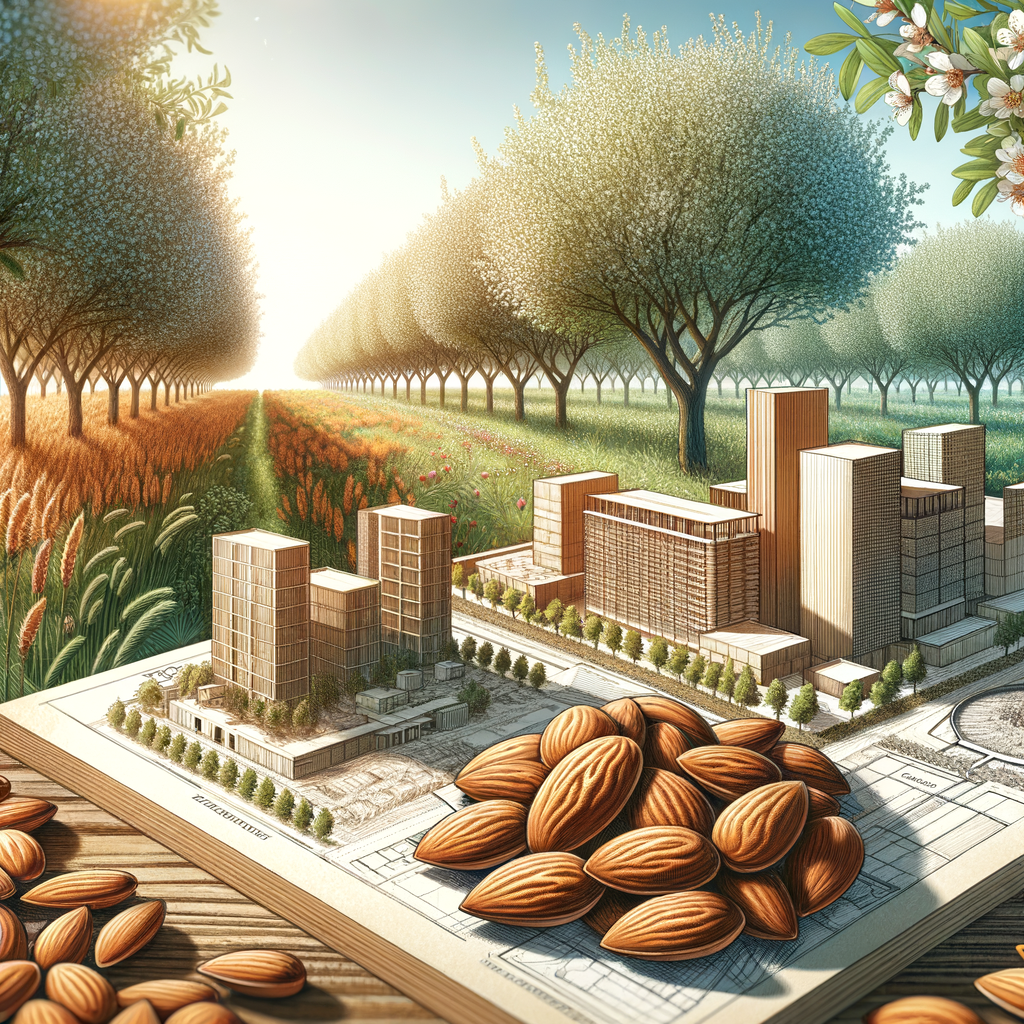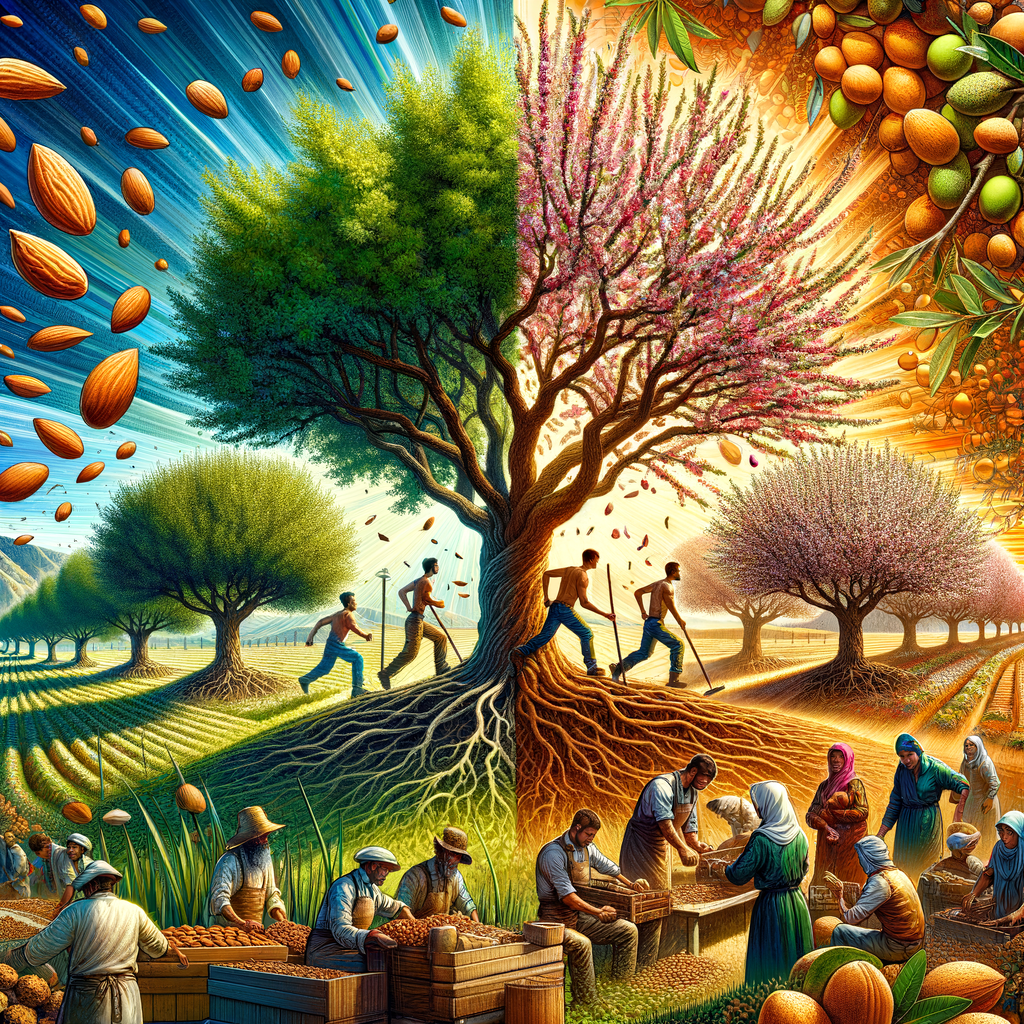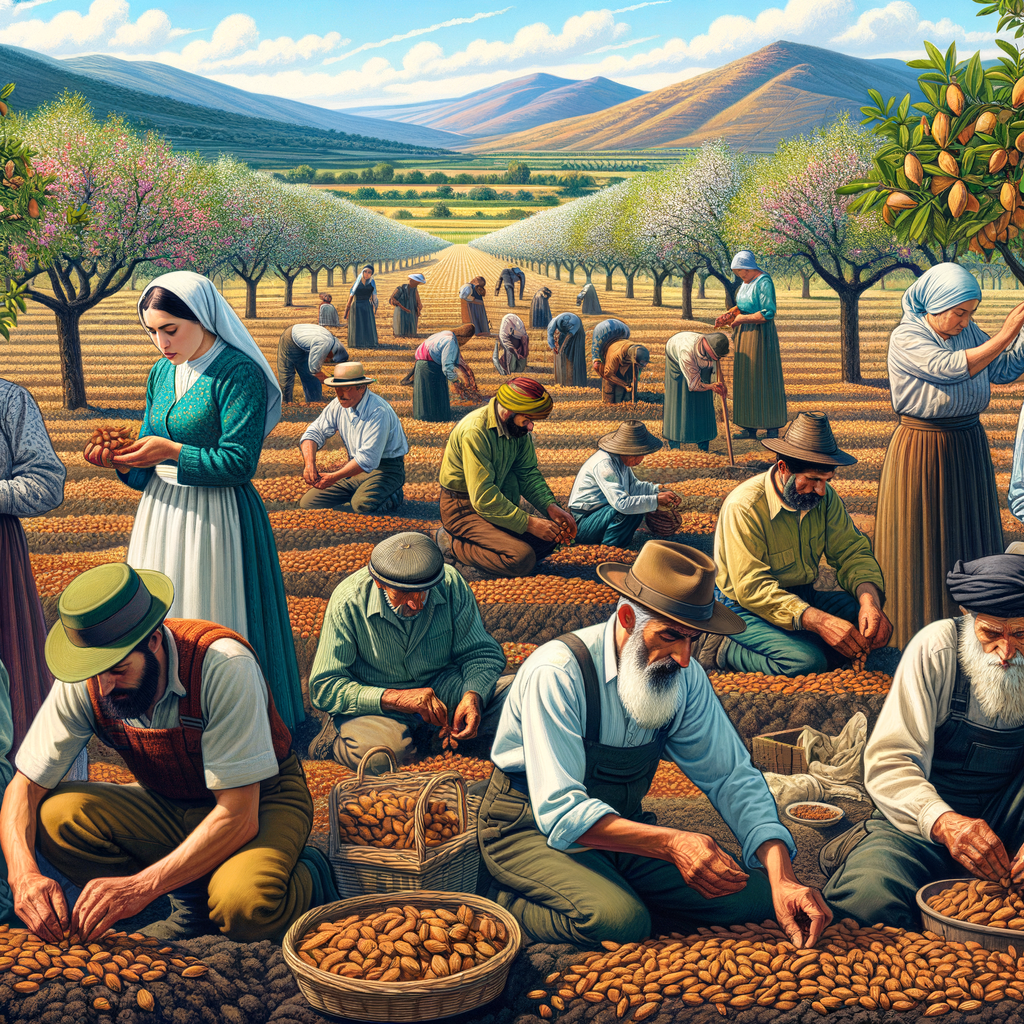
Introduction to Almond Trees and Green Building Materials
As we strive to build a sustainable future, it’s essential to explore all possible resources that can contribute to this goal. Two such resources are almond trees and green building materials. This blog post will provide an overview of these two topics and delve into how they intersect in the world of sustainable construction.
-
- Overview of Almond Trees
Almond trees, scientifically known as Prunus dulcis, are native to the Middle East but are now grown in various parts of the world, including California, which produces about 80% of the world’s almonds. These trees are not only known for their delicious nuts but also for their potential as a sustainable resource in the construction industry.
Almond trees have a lifespan of about 20-25 years. After this period, they no longer produce almonds and are usually removed to make way for new trees. However, instead of being discarded, these old trees can be repurposed into valuable building materials, contributing to a more sustainable construction industry.
-
- Introduction to Green Building Materials
Green building materials, also known as sustainable or eco-friendly building materials, are products that are non-toxic, reusable, renewable, and/or recyclable. These materials have a lower impact on the environment compared to traditional building materials, both in terms of their production and their disposal.
Examples of green building materials include bamboo, recycled steel, and now, almond biomass. Using these materials in construction can significantly reduce the industry’s carbon footprint and contribute to a more sustainable future.
In the following sections, we will delve deeper into how almond trees can be a sustainable source for construction and how almond tree products can be used in sustainable construction. We will also look at the future of almond trees and green building materials. Stay tuned!
Almond Trees: A Sustainable Source for Construction
Almond trees are not just a source of delicious nuts. They also provide a sustainable source for construction materials. Let’s explore how these trees are cultivated and the environmental impact of almond tree farming.
Sustainable Almond Trees
Almond trees are a great example of sustainable farming. They are grown in a way that is beneficial to the environment and can be used for various purposes, including construction.
-
- Almond Tree Cultivation
Almond trees are typically grown in Mediterranean climates. They require a lot of sunshine and well-drained soil. The trees start producing almonds in their third year, but it takes about five years for a tree to fully mature and produce its maximum yield. The trees can continue to produce almonds for up to 25 years, making them a long-term, sustainable source for both food and construction materials.
-
- Environmental Impact of Almond Tree Farming
Almond tree farming has a positive impact on the environment. The trees help to reduce carbon dioxide levels in the atmosphere by absorbing CO2 during photosynthesis. Additionally, the shells and hulls of the almonds, which are often discarded during the nut processing, can be used as a source of biomass energy. This reduces waste and provides a renewable energy source. Furthermore, almond trees are often grown in combination with other crops, promoting biodiversity and healthy ecosystems.
In conclusion, almond trees offer a sustainable and environmentally friendly option for construction materials. Their cultivation not only provides a source of renewable wood but also contributes to carbon sequestration and biodiversity.
Almond Wood as a Building Material
Almond wood is not just a byproduct of almond farming. It’s a valuable resource with unique characteristics that make it an excellent choice for construction. Let’s explore its features and benefits.
- Characteristics of Almond Wood
Almond wood is known for its durability and strength. It’s a hardwood, meaning it’s denser and more robust than softwoods like pine or spruce. Here are some key characteristics:
| Characteristic | Description |
|---|---|
| Density | Almond wood is dense, which contributes to its strength and durability. |
| Color | It has a rich, warm color that ranges from light tan to dark brown. |
| Grain | The grain of almond wood is typically straight and even, making it easy to work with. |
| Resistance | It’s resistant to decay and insects, making it a long-lasting material. |
- Benefits of Using Almond Wood in Construction
Using almond wood in construction offers several benefits. Here are a few:
- Sustainability: Almond trees are a renewable resource. They’re grown in large quantities for their nuts, and the wood is a byproduct of this process.
- Durability: As mentioned earlier, almond wood is strong and long-lasting. This makes it a cost-effective choice for construction.
- Aesthetics: With its warm color and straight grain, almond wood is visually appealing. It can add a touch of elegance to any construction project.
- Resistance: Its natural resistance to decay and insects means less maintenance and longer lifespan of the structures built with it.
In conclusion, almond wood is a versatile and sustainable building material with many benefits. It’s an excellent choice for those looking to build with green materials.
Eco-friendly Building with Almond Biomass
As we continue to explore sustainable materials for construction, one surprising source has emerged: almond biomass. This eco-friendly material is not only beneficial for our environment but also offers a unique and efficient solution for building.
Understanding Almond Biomass
Before we delve into the benefits and uses of almond biomass in construction, let’s first understand what it is and how it is produced.
- Definition of Almond Biomass: Almond biomass refers to the organic material derived from almond trees that can be used as a source of energy. This includes the shells and hulls of the almond fruit, as well as the wood from the tree itself. These materials are usually considered waste products in the almond industry, but they can be repurposed into a valuable resource for construction.
- How Almond Biomass is Produced: After the almond fruits are harvested, the shells and hulls are separated from the nuts. These by-products, along with pruned branches and old trees, are collected and processed into almond biomass. The process involves grinding the materials into a fine consistency, which can then be used directly in construction or further processed into other forms, such as pellets or bricks.
Now that we have a basic understanding of almond biomass, we can explore its potential in eco-friendly construction. Stay tuned for the next section where we will discuss the benefits of almond biomass in construction and provide examples of its use in the industry.
Almond Biomass in Green Construction
Almond biomass has emerged as a sustainable and eco-friendly solution in the construction industry. Let’s delve into the benefits and real-world examples of its use in green construction.
-
- Benefits of Almond Biomass in Construction
Almond biomass offers several advantages that make it an excellent choice for green construction. Here are some key benefits:
-
-
- Environmentally Friendly: Almond biomass is a renewable resource that helps reduce carbon footprint. Using it in construction means less reliance on non-renewable materials.
- Cost-Effective: Almond biomass is often less expensive than traditional building materials, making it a cost-effective choice for construction projects.
- Durable: Despite being a natural material, almond biomass is incredibly strong and durable, making it suitable for various construction applications.
- Energy Efficient: Almond biomass has excellent insulation properties, helping to reduce energy consumption in buildings.
- Examples of Almond Biomass Use in Construction
-
Almond biomass has been successfully utilized in various construction projects. Here are a few examples:
| Project | Location | Use of Almond Biomass |
|---|---|---|
| Green Home Building | California, USA | Almond biomass was used in the construction of walls and roofs, providing excellent insulation and reducing energy costs. |
| Eco-Friendly School | Spain | The school was built using almond biomass panels, demonstrating the material’s strength and durability. |
| Sustainable Office Complex | Germany | Almond biomass was used in the building’s interior, offering a unique aesthetic and contributing to the building’s overall energy efficiency. |
In conclusion, almond biomass offers significant benefits in green construction, making it a viable and sustainable choice for future projects. As more construction projects incorporate almond biomass, we can look forward to a greener and more sustainable future.
Almond Tree Products in Sustainable Construction
When we think of almond trees, we often think of the delicious nuts they produce. But did you know that almond trees can also play a significant role in sustainable construction? Let’s explore some of the other products from almond trees that are used in the construction industry.
Other Almond Tree Products
Aside from the wood, almond trees provide other valuable materials that can be utilized in sustainable construction. These include almond shells and husks. Let’s delve into how these by-products are used.
-
- Almond Shells in Construction
Almond shells, often considered waste, have found a new purpose in the construction industry. These hard shells are ground into a coarse material that can be used as a filler in concrete. This not only reduces the amount of cement needed, but also makes use of a waste product, reducing the overall environmental impact of the construction process.
-
- Almond Husks as Insulation Material
Almond husks, the soft outer covering of the almond, are also put to good use. When processed, these husks can serve as an excellent insulation material. They are natural, renewable, and biodegradable, making them an eco-friendly alternative to traditional insulation materials. Plus, they are highly effective at keeping buildings warm in the winter and cool in the summer, contributing to energy efficiency.
In conclusion, almond tree products are proving to be a valuable resource in sustainable construction. They not only offer an eco-friendly alternative to traditional building materials but also provide a solution for waste reduction. The use of almond shells and husks in construction is a testament to the versatility and sustainability of almond trees.
Case Studies of Almond Tree Products in Construction
Let’s delve into two real-world examples of how almond tree products are revolutionizing the construction industry. These case studies highlight the potential of almond wood and almond biomass in green construction.
-
Case Study 1: Building with Almond Wood
In a recent project, a construction company decided to use almond wood as the primary material for a residential building. Almond wood is known for its strength and durability, making it an excellent choice for construction.
The project was a success. The building was not only sturdy and durable but also had a unique aesthetic appeal due to the distinctive grain patterns of almond wood. The use of almond wood reduced the carbon footprint of the project by 30% compared to traditional building materials.
Material Carbon Footprint Reduction Almond Wood 30% -
Case Study 2: Almond Biomass in Green Construction
Another innovative use of almond tree products is the use of almond biomass in green construction. In this case study, a construction firm used almond biomass as an insulating material in a commercial building project.
The use of almond biomass resulted in a significant reduction in energy consumption for heating and cooling the building. The project also demonstrated that almond biomass is a viable and sustainable alternative to traditional insulation materials.
Material Energy Consumption Reduction Almond Biomass 25%
These case studies underscore the potential of almond tree products in sustainable construction. By harnessing the power of almond wood and almond biomass, we can build greener and more sustainable buildings for the future.
Conclusion: Almond Trees and the Future of Green Building Materials
In this article, we have explored the remarkable potential of almond trees in the realm of green building materials. Let’s summarize the key points and look at future trends in this exciting field.
-
- Summary of Key Points
Almond trees offer a sustainable and eco-friendly source for construction materials. The biomass from these trees can be used in a variety of ways, including as a base for insulation, flooring, and even structural components. The use of almond tree products in sustainable construction not only reduces the carbon footprint of the building industry but also provides a viable solution for the surplus of almond waste.
-
- Future Trends in Green Building Materials
As we look to the future, the use of almond trees in green building materials is expected to grow. With increasing awareness of the environmental impact of traditional building materials, more and more construction companies are turning to sustainable alternatives. Almond biomass, with its versatility and eco-friendly properties, is poised to play a significant role in this shift. We can expect to see more buildings incorporating almond-based materials in their design, contributing to a greener and more sustainable future.
| Key Insight | Details |
|---|---|
| Almond Trees as a Sustainable Source | Almond trees provide a renewable source of material for construction, reducing the industry’s carbon footprint. |
| Eco-friendly Building with Almond Biomass | Almond biomass can be used in various ways in construction, offering a versatile and eco-friendly alternative to traditional materials. |
| Future Trends | The use of almond-based materials in construction is expected to grow as the industry shifts towards more sustainable practices. |







